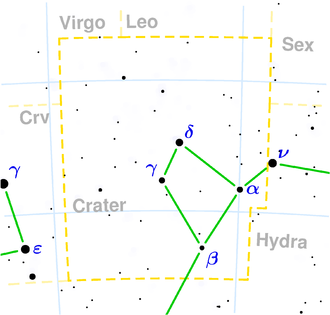NGC 3520
| Galaxy NGC 3520 |
|
|---|---|

|
|
| AladinLite | |
| Constellation | cups |
|
Position equinox : J2000.0 , epoch : J2000.0 |
|
| Right ascension | 11 h 07 m 09.2 s |
| declination | -18 ° 01 ′ 25 ″ |
| Appearance | |
| Morphological type | E + 4 pec |
| Brightness (visual) | 13.3 mag |
| Brightness (B-band) | 14.3 mag |
| Angular expansion | 1.3 ′ × 1 ′ |
| Position angle | 165 ° |
| Surface brightness | 13.7 mag / arcmin² |
| Physical data | |
| Redshift | 0.069688 ± 0.000150 |
| Radial velocity | 20892 ± 45 km / s |
|
Stroke distance v rad / H 0 |
(926 ± 65) · 10 6 Lj (283.8 ± 19.9) Mpc |
| history | |
| discovery | Francis Leavenworth |
| Discovery date | 1886 |
| Catalog names | |
| NGC 3520 • PGC 33648 • ESO 570-G004 • 2MASX J11070920-1801255 • | |
NGC 3520 is an elliptical galaxy from the Hubble type E1 / P in the constellation cup. It is estimated to be 926 million light years from the Milky Way . In optical proximity there is an asterism, consisting of 4 to 5 stars, which is about 4000 light years from Earth.
The object was discovered in 1886 by the astronomer Francis Leavenworth .
Individual evidence
- ↑ a b c d e NASA / IPAC EXTRAGALACTIC DATABASE
- ↑ a b c SEDS: NGC 3520
- ↑ AL Tadross: A catalog of 120 NGC open star cluster . In: Journal of the Korean Astronomical Society , 44, 2011, pp. 1-11. doi: 10.5303 / JKAS.2011.44.1.1 .
- ↑ Seligman
